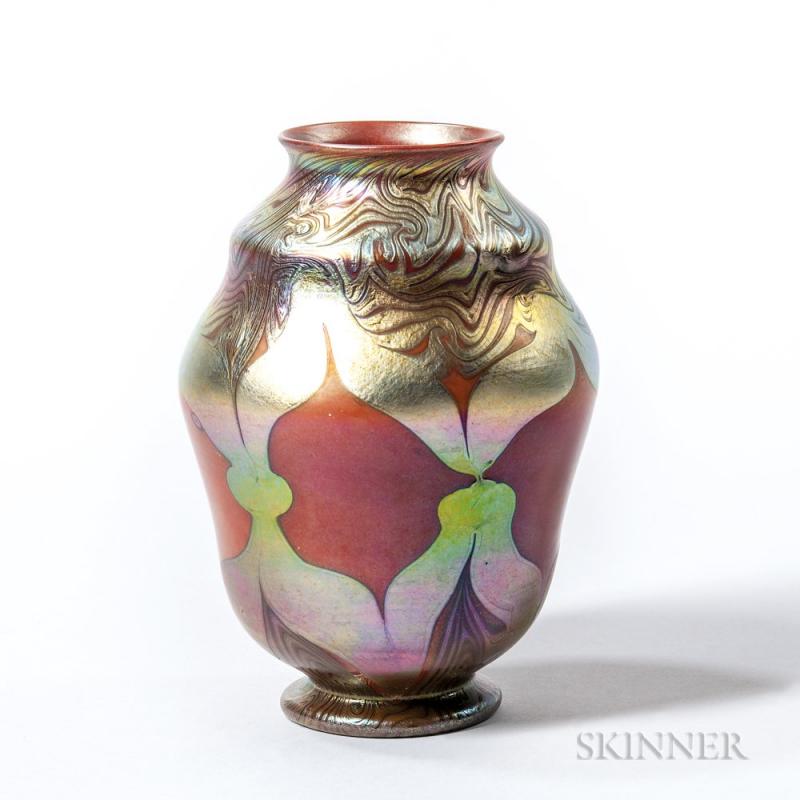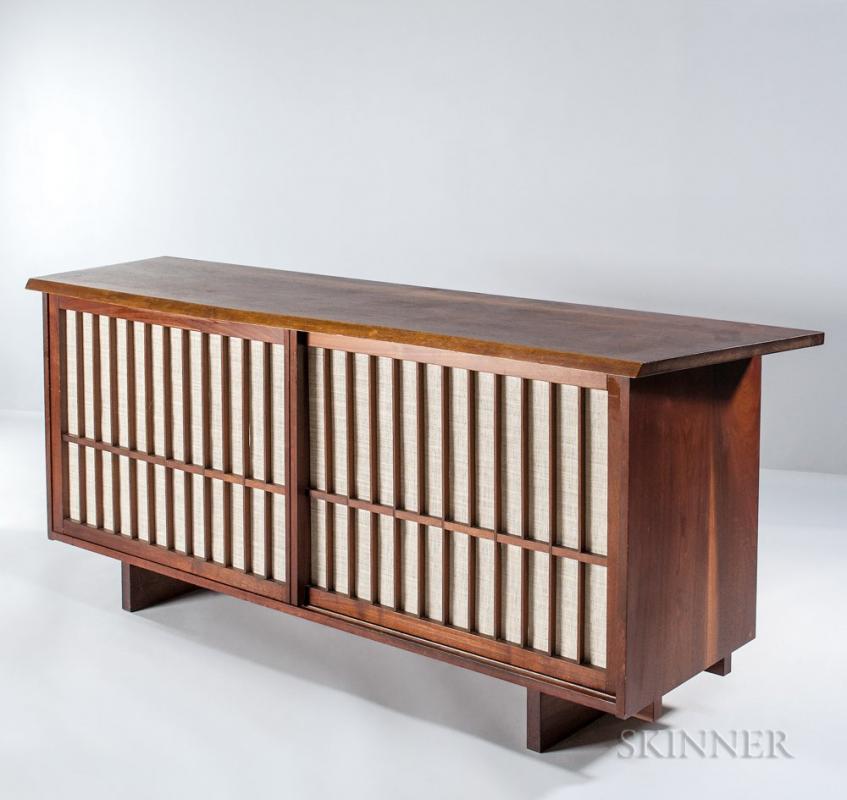Tiffany Glass, George Nakashima, and Swingline Collection Furniture Lead Skinner 20th Century Design Auction
Skinner’s 20th Century Design auction was well received in Boston on December 14. Its success repeats the consistent pattern of Skinner sales: famous names and iconic objects, intermingled with obscure masterpieces and unexpected treasures.
Lot 72, Tiffany Favrile, Art glass, New York, c. 1900; Sold for $33,210
The top lot of the auction, as well as many other pieces in the top ten, came from the fresh-to-market Nan Edwards collection of high-quality art nouveau glass. The rare red Tiffany Favrile exhibition vase, Lot 72, brought $33,210, far above the pre-auction estimate of $4,000-6,000.
The private buyer of the piece exclaimed to department director Jane Prentiss, “For the many years that I have been collecting Art Glass, I have wanted a red Tiffany to add to my collection. And then came THE ONE from the Nan Edwards Collection. I am very happy to now have such a beautiful “red.”
Lot 354, George Nakashima Cabinet, Walnut, natural fiber cloth; Sold for $22,140
In 20th century design, as in every collecting area, the best of the best dominate the marketplace. Great names such as Tiffany and Nakashima—Lot 354, a Nakashima cabinet, was the second-highest lot in the sale—are dependable stand-outs at Skinner’s sales. What about the unexpected highlight of the kind for which Skinner is known?
Lot 328, Two Multicolored Storage Units; Sold for $17,220
The third-ranking lot was just such a Skinner surprise. Lot 328, two multicolored storage units c. 1958 by Henry P. Glass for his children’s line, fetched $17,220 over a pre-auction estimate of $200-300. Glass had a 60-year career in modern design. His futuristic yet functional furniture combined ingenious construction, economy of means, and creative use of new post-war materials such as aluminum and plywood.
These two storage units were part of his inventive Swingline children’s plywood furniture collection. The color-coded panels were intended to help children organize their clothing and possessions. Unlike many of Glass’ other innovative and practical designs, Swingline furniture was a commercial failure. But, as this sale proved, an appreciative audience is emerging sixty years later.
The growing audience for 20th century design is spirited and adventurous. Numerous buyers got back to Jane Prentiss to express their satisfaction with their purchases, often commenting on their pleasure in finding a long-sought-after piece. Jane reflects, “It was great to see such enthusiasm over this collection. It is so satisfying to link a seller to a new steward or buyer who is going to care for an object and enjoy it as much as the previous owner did.”
By Bidsquare
Copyright © 1999 - 2024 Bidsquare. All Rights Reserved.
- ON MAY 11, TURNER AUCTIONS + APPRAISALS IS DEVOTED TO ICONS: ONE MAN’S COLLECTION
- Rafael Osona's April 27 Daffodil Weekend Auction Artistry and Fine Craftsmanship
- A SECRET VAULT OPENS ON APRIL 21 AT TURNER AUCTIONS + APPRAISALS
- FINE ART: ONE MAN’S COLLECTION GOES UP FOR BID ON APRIL 6 AT TURNER AUCTIONS + APPRAISALS
- TIMING IS EVERYTHING: VINTAGE WATCHES GO UP FOR BID ON MARCH 24 AT TURNER AUCTIONS + APPRAISALS
- THE ESTATE OF EDWARD S. STEPHENSON FEATURES ARMS & ARMOR AND ASIAN DECORATIVE ARTS
- Discover Timeless Elegance at the 'Elegant Artistry: Rug and Art Auction'
- ANIMAL ART IS GETTING ALL THE LOVE IN PALM BEACH ON FEB 17th
- RETABLOS: THE ART OF DEVOTION GOES UP FOR BID ON FEBRUARY 24 AT TURNER AUCTIONS + APPRAISALS
- 100 Years | The Kindig Legacy
-
Sporting Immortality

-
Antique Toy Auction at Pook & Pook Inc, with Noel Barrett
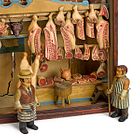
-
The Collection of Mrs. John Gutfreund – Murray House, Villanova, Pennsylvania
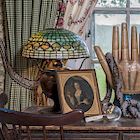
-
Leonora Carrington Oil Painting Sells for More Than Twice the Asking Price in the Latin American Art Auction Hosted by Morton Subastas in Mexico City
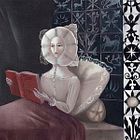
-
Peter Tillou Collection Highlights Litchfield Auctions’ 25th Anniversary




 EUR
EUR CAD
CAD AUD
AUD GBP
GBP MXN
MXN HKD
HKD CNY
CNY MYR
MYR SEK
SEK SGD
SGD CHF
CHF THB
THB
